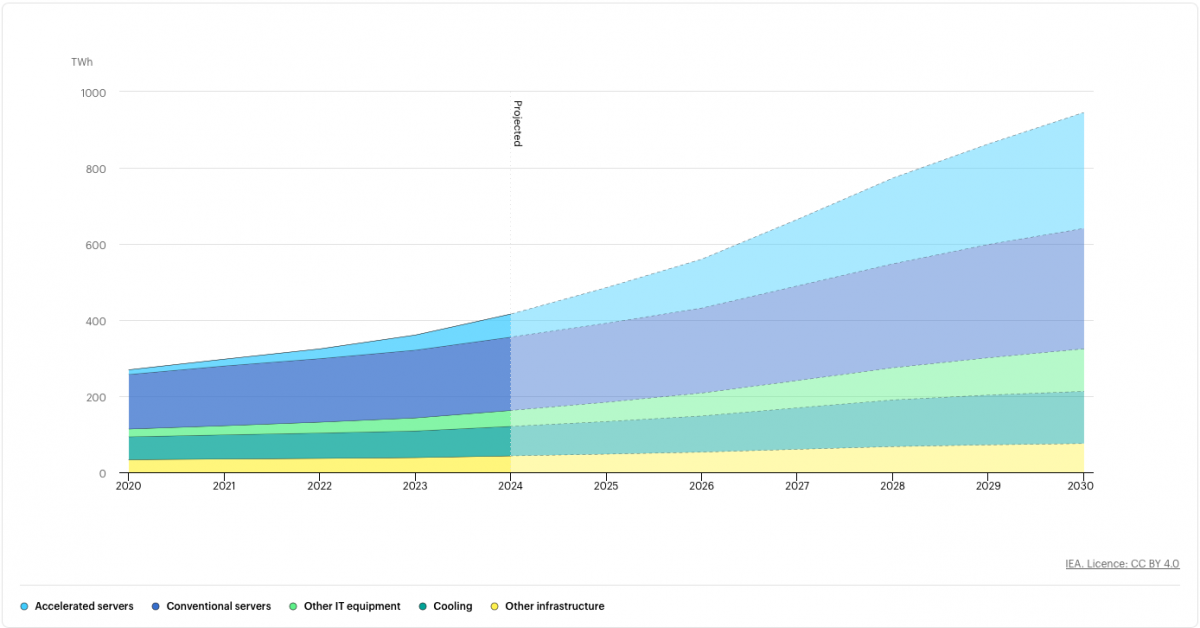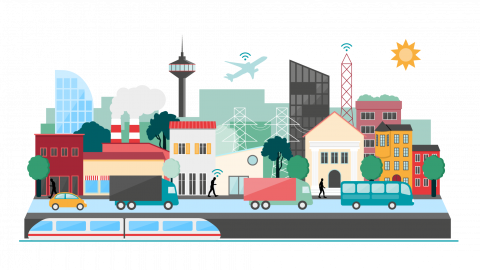In our previous article, we dug into the raw numbers behind cloud and AI energy use. But sustainability isn’t only about terawatt-hours and cooling systems. It’s also about choices — the strategic, architectural, and operational decisions that shape how digital infrastructure behaves in the real world
This post looks at what sustainable practice actually means in cloud and AI today, and how we, as a technology partner, think about our role.
Growth demands responsibility
Cloud and AI adoption are accelerating fast. Analysts expect global electricity demand from data centres to more than double over the coming years. Data facilities already account for a meaningful share of global electricity use, and their footprint continues to grow.
That growth is powerful — it drives innovation, automation, and new digital opportunities. But it also comes with responsibility. Real sustainability isn’t created by marketing slogans or offset statements; it requires real action and measurable progress.

What sustainable practice looks like
- Smarter workload management - Efficient cloud architecture reduces energy waste. Autoscaling, batching tasks, and shutting down idle resources are proven ways to minimise unnecessary compute consumption. Increasingly, predictive models help forecast demand and right-size capacity — matching resources to real needs, not just peak theory.
- Migration done right - Moving from legacy on-premise systems to modern cloud platforms can significantly reduce emissions — but only if done thoughtfully. Simply lifting and shifting legacy workloads to the cloud only relocates inefficiency. True sustainability comes from modernisation, refactoring, and adopting cloud-native patterns.
- Heat reuse - In colder regions, waste heat from data centres can be captured and reused for district heating or industrial processes. Rather than letting heat dissipate unused, infrastructure can feed energy back into its surroundings — a practical example of circular thinking in digital systems.
- Water-aware cooling - Cooling strategies matter. Closed-loop cooling or hybrid models reduce stress on water systems in vulnerable regions. In northern climates, natural cooling advantages dramatically lower resource usage — geography can be a sustainability asset.
- Transparency and standards - Sustainability requires trust — and trust comes from verifiable data. European initiatives like the Climate Neutral Data Centre Pact and regulatory frameworks like CSRD push providers toward audited, transparent reporting. Sustainability without proof is just marketing.
- Hardware and model efficiency - Rapid advances in chip design, AI accelerators, and efficient model architectures are reducing the energy required per computation. Smaller task-specific models and more efficient inference pipelines are becoming as important as hardware in reducing footprint.
How we see our role
At Redpill Linpro, we believe sustainability in the cloud isn’t defined by a single technology choice or certification, but by everyday engineering decisions, procurement discipline, platform design, and how we guide customers through change.
It starts with infrastructure. We work with data centre partners that commit to renewable power and efficiency — not just in policy slides, but in contracts, monitoring, and continuous reporting. We don’t rely on “green by claim”; we require traceability and measurable progress.
Equally important is how platforms are built and operated. A sustainable cloud is a designed cloud. That means autoscaling, minimising idle workloads, setting smart defaults, and helping developers think about impact as well as performance. We apply these principles in our own services and bring customers along through migration and modernisation work.
Transparency is another cornerstone. ESG and CSRD reporting are not box-ticking exercises for us — they are mechanisms for trust. Real sustainability must be auditable, comparable, and open to scrutiny.
And crucially, sustainability is a collaborative effort. We don’t believe in solving this alone — nor could we. Our company grew up in the open-source world, long before it was mainstream. From the early days of Linux communities and open standards, we’ve built our culture on transparency, contribution, and knowledge-sharing. That mindset naturally extends to sustainability: sharing what works, learning from peers, contributing to industry bodies, and pushing for open, verifiable practices across the digital ecosystem. Collaboration built the internet; it will also build a greener one.
Technology is evolving quickly, and expectations are rising with it. Our role is to ensure our customers move forward not only with modern, scalable platforms — but with cloud choices that make sense environmentally, ethically, and long-term.
The challenges and trade-offs
Efficiency doesn’t guarantee lower total use. As technology becomes more efficient, demand can rise faster — the rebound effect sometimes called the Jevons paradox. Sustainable design must therefore include prioritisation, awareness, and restraint.
Likewise, sustainability claims must be understood in context. “100% renewable matching” does not always mean the same thing as “100% renewable power, at the same time and place as use.” Timing, geography, and grid conditions matter.
And sustainability isn’t universal — what works in Norway’s hydropower-driven environment may not be applicable in regions facing water stress or fossil-heavy grids. Context matters.
A continuous journey
Sustainability in cloud and AI is not a destination — it is an ongoing discipline of improvement, transparency, and thoughtful design.
We will continue to build platforms that reduce waste, help customers adopt efficient architectures, and share data openly about our own progress. And we will keep contributing to the broader ecosystem, because a sustainable digital future is something we build together.
Cloud and AI are shaping the future. Our responsibility is to help make sure that future is one worth building.
Sources and further reading
- International Energy Agency — Data centres and AI outlook: https://www.iea.org/reports/energy-and-ai
- International Energy Agency — Electricity 2024 report: https://www.iea.org/reports/electricity-2024
- Digital Realty — Sustainable Data Centre & AI Practices: https://www.digitalrealty.co.uk/resources/articles/sustainable-data-centre-ai
- Microsoft — Cloud Adoption Framework Sustainability Guidance: https://learn.microsoft.com/en-us/azure/cloud-adoption-framework/strategy/inform/sustainability
- European Data Centre Association — Waste Heat Reuse Guidance: https://www.eudca.org/
- ASHRAE — Thermal Guidelines for Data Processing
- Environments: https://www.ashrae.org/technical-resources/bookstore/datacom-series
- Climate Neutral Data Centre Pact: https://www.climateneutraldatacentre.net/
- European Commission — CSRD
- Framework: https://finance.ec.europa.eu/sustainable-finance/corporate-sustainability-reporting_en
- Amazon / Google / Meta sustainability reports: https://sustainability.aboutamazon.com https://sustainability.google https://ai.facebook.com/blog
- UK Government — Rebound effect research: https://www.gov.uk/government/publications/rebound-effects-from-energy-efficiency
- Reuters — Cloud emissions reporting: https://www.reuters.com/technology



